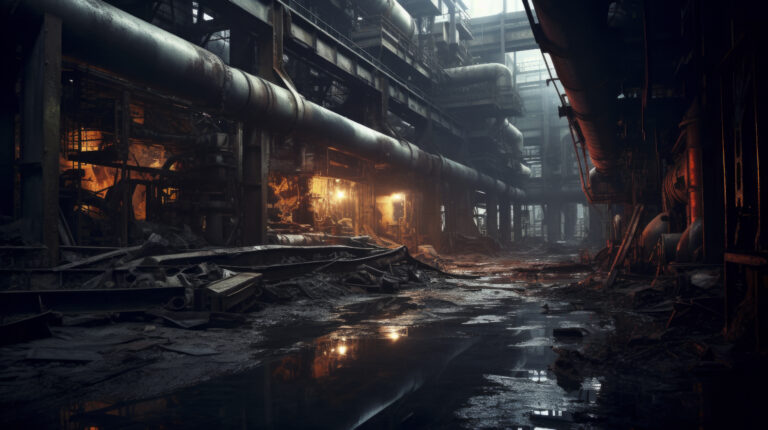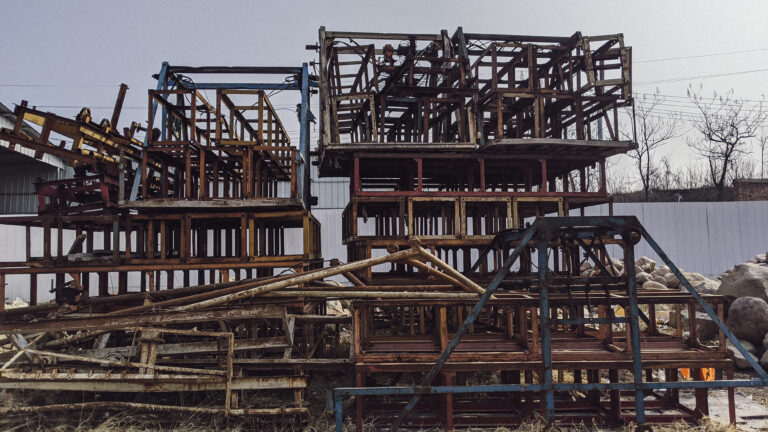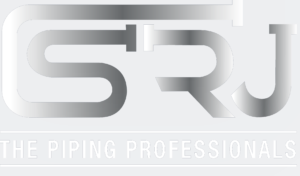Industrial Steel Structure Disasters: How to Prevent Costly Collapses
Table of Contents
Did you know that structural failures in industrial settings lead to billions of dollars in damages and countless injuries each year? Safety in industrial operations, particularly concerning steel structures, is paramount. This comprehensive safety guide delivers critical, actionable protocols essential for preventing costly collapses, protecting personnel, and ensuring regulatory compliance.
You will learn how to identify potential hazards, implement robust maintenance programs, and adhere to the highest safety standards, transforming your approach to structural integrity and overall workplace safety.
Understanding Industrial Steel Structure Regulations
Numerous regulatory bodies and standards govern the design, construction, maintenance, and inspection of steel structures. Key players include OSHA (Occupational Safety and Health Administration), which sets and enforces workplace safety standards; ANSI (American National Standards Institute), which develops voluntary consensus standards; and local building codes, which vary by jurisdiction.
Specific standards, such as those published by the AISC (American Institute of Steel Construction) and AWS (American Welding Society), provide detailed guidelines for steel fabrication, erection, and welding.
Non-compliance can lead to severe consequences, including hefty fines, legal liabilities, project delays, and, most importantly, loss of life. A proactive approach to compliance, involving regular audits, training, and adherence to best practices, is crucial for maintaining a safe operating environment.

Steel Structure Design Safety Protocols
Proper design is the foundation of structural safety. Design flaws are a significant contributor to the collapse of steel structures. The design phase must account for all potential loads, including dead loads (the weight of the structure itself), live loads (occupancy and equipment), environmental loads (wind, snow, and seismic activity), and dynamic loads (vibration and impact).
A detailed structural analysis, utilizing sophisticated software and considering all potential failure modes, is essential. Redundancy should be built into the design, providing alternative load paths in case of component failure. Connections, often the weakest points in a structure, must be designed with meticulous attention to detail.
Material Selection and Quality Control Safety Protocols
The quality of the steel used in construction has a direct impact on the structural integrity. Specify steel grades that meet or exceed required standards, ensuring they possess the necessary strength, ductility, and weldability.
Implement a rigorous quality control program that includes material testing, inspection of mill certificates, and verification of compliance with specifications. Conduct regular audits of suppliers to ensure they adhere to quality standards. Traceability of materials, from the mill to the final installation, is crucial for identifying and addressing potential defects.
Welding and Fabrication Safety Protocols
Welding is a critical process in steel structure construction, and welding failures can have catastrophic consequences. Employ certified welders who are proficient in the specific welding techniques required for the project.
Adhere strictly to welding procedures that comply with American Welding Society (AWS) standards. Ensure proper joint preparation, welding parameters, and post-weld inspection. Non-destructive testing (NDT) methods, such as ultrasonic testing and radiographic testing, should be used to detect weld defects. Visual inspection alone is insufficient.
Erection and Assembly Safety Protocols
The erection and assembly phase presents significant safety challenges. Develop a detailed erection plan that addresses lifting procedures, temporary bracing, and worker safety.
Use qualified riggers and crane operators. Inspect all lifting equipment before each use. Ensure that workers are adequately trained in safe erection practices. Implement fall protection measures, such as safety harnesses and nets, to prevent falls from height.
Corrosion Prevention Safety Protocols
Corrosion is a significant threat to steel structures, weakening the material and leading to eventual failure. Implement a comprehensive corrosion prevention program that includes protective coatings, cathodic protection, and regular inspections to ensure optimal safety and reliability.
Select coatings appropriate for the environment and ensure proper surface preparation before application. Regularly inspect coatings for damage and repair as needed. Consider using corrosion-resistant alloys in environments with corrosive conditions.
Fire Protection Safety Protocols
Steel loses strength at high temperatures, making fire protection a critical consideration. Apply fire-resistant materials, such as intumescent coatings or concrete encasement, to protect steel members from fire damage.
Design fire suppression systems, such as sprinklers, to quickly extinguish fires. Develop and implement a comprehensive fire safety plan that includes evacuation procedures and fire drills. Regularly inspect and maintain fire protection systems.
Seismic Design Safety Protocols
In seismically active areas, steel structures must be designed to withstand the forces of earthquakes. Incorporate seismic design principles into the structural design, following relevant building codes and standards.
Use ductile materials and connections that can absorb energy during an earthquake. Conduct a seismic risk assessment to identify potential vulnerabilities and implement mitigation measures. Regularly inspect structures for earthquake damage after seismic events.
Overloading Prevention Safety Protocols
Overloading can cause catastrophic structural failure. Establish clear load limits for the structure and implement measures to prevent overloading. Monitor loads regularly and ensure they do not exceed design limits.
Provide training to personnel on load limits and the consequences of exceeding load limits. Implement load monitoring systems, such as strain gauges, to detect overloading in real-time. Regularly inspect structures for signs of overloading, such as excessive deflection or cracking.
Preventive Maintenance for Steel Structures
Regular inspection and maintenance are crucial for identifying and addressing potential problems before they lead to failure. Develop a comprehensive preventive maintenance program that includes regular inspections, thorough cleaning, and timely repairs.
Train personnel to recognize signs of deterioration, including corrosion, cracking, and deformation. Keep detailed records of inspections and maintenance activities. Address any identified problems promptly.
Steel Structure Inspection Quality Checklist
A comprehensive inspection checklist is an essential tool for ensuring structural integrity. The checklist should include items such as:
- Visual inspection for corrosion, cracking, and deformation
- Inspection of welds for defects
- Inspection of connections for loose or missing fasteners
- Inspection of coatings for damage
- Verification of load limits
- Assessment of environmental factors
- Review of maintenance records
The checklist should be updated regularly to reflect changes in the structure or operating conditions.
Environmental Factors Safety Protocols
Environmental factors, such as temperature, humidity, and chemical exposure, can significantly impact the lifespan and integrity of steel structures. Consider these factors during the design phase and implement measures to mitigate their effects.
Use corrosion-resistant materials in harsh environments. Provide adequate ventilation to reduce humidity. Protect steel structures from chemical exposure. Regularly inspect structures for environmental damage.
Human Error and Operational Safety Protocols
Human error is a contributing factor in many structural failures. Implement measures to reduce the risk of human error, such as providing adequate training, establishing clear procedures, and promoting a safety culture.
Ensure that personnel are aware of potential hazards and know how to respond to emergencies. Encourage open communication and reporting of safety concerns. Conduct regular safety audits to identify possible weaknesses in the system.
Case Studies of Steel Structure Collapses
Analyzing past collapses can provide valuable lessons for preventing future incidents. Documented case studies reveal common causes, such as design flaws, material defects, inadequate maintenance, and human error.
Understanding the root causes of these failures can help organizations identify potential vulnerabilities in their structures and implement corrective measures. Share case studies with personnel to raise awareness of the possible consequences of neglecting safety protocols.
Emergency Response and Evacuation Plans
Despite the best efforts at prevention, structural failures can still occur. Develop and implement a comprehensive emergency response and evacuation plan to minimize the impact of a collapse.
The plan should include procedures for notifying emergency services, evacuating personnel, and securing the site in the event of an emergency. Conduct regular drills to ensure that personnel are familiar with the plan. Provide training to personnel on how to respond to different types of emergencies.
Risk Assessment & Hazard Identification
Hazard identification involves systematically identifying potential dangers in the industrial environment. This includes evaluating all aspects of the operation, from the materials used to the processes employed and the equipment involved. Conduct regular walk-throughs, review safety data sheets (SDS), and analyze accident reports to uncover potential hazards.
Risk assessment involves evaluating the likelihood and severity of potential hazards. Utilize techniques such as Failure Mode and Effects Analysis (FMEA) and Hazard and Operability (HAZOP) studies to assess risks thoroughly. Develop a risk assessment matrix to prioritize hazards based on their potential impact and likelihood of occurrence. Implement mitigation strategies to reduce or eliminate identified risks.
Safety Training & Culture Development
Implementing robust safety protocols is not merely a regulatory requirement; it is a fundamental responsibility. By prioritizing safety in steel structure design, construction, maintenance, and operation, organizations can prevent costly collapses, protect their workforce, and ensure the long-term sustainability of their operations. A strong safety culture, coupled with diligent adherence to best practices, is the key to creating a safe and productive industrial environment.
Request a comprehensive safety audit for your facility from SRJ Piping India and proactively safeguard your operations against potential disasters. Contact us for expert safety consultation and ensure your steel structures meet the highest safety standards.

Conclusion
Successfully implementing cost-saving measures in pipe fabrication projects requires a holistic approach that focuses on efficiency and value at every stage. By systematically addressing these areas, you can unlock significant savings and improve the financial performance of your pipe fabrication projects. Begin your initial assessment today and pave the way for more cost-effective and successful outcomes.
Do you need expert assistance, or are you looking for a fabrication partner that prioritizes cost optimization? Discover SRJ Piping India’s solutions next.
Worried About Structural Failures in Your Facility?
Get a professional safety audit to prevent collapses, ensure compliance, and secure your steel structures for the long term.
